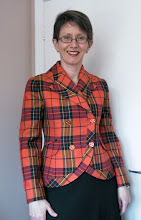I believe I promised you information on how I hope to be free from laborious calculations for my machine knitting projects.
I bought software! Behold, at left, a top I made using it. (More details on the project below.)
Some machine knitters use a program called Design-A-Knit (DAK) but I couldn't warm to it. For one thing, the price is rumored to be many hundreds of US dollars (the website for the US distributor is remarkably bad, it's impossible to even find purchase details like cost). Also, I had looked at the demo and it didn't make a lot of sense to me. Plus, maybe it's more than I need.
So instead, I purchased Garment Designer, a program for creating patterns for sewing and knitting. Like DAK (currently on version 9), GD has been around for many years. I had heard of it way back in the day when I was working with PatternMaster Boutique (PMB).
My impression at the time was that GD was a less powerful program than PMB. I think I was right - while you can alter the basic shapes provided by GD to a point, it is not a full CAD type program. However, the positive side of that is that it does a lot of the hard work for you in providing those basic shapes. (As I recall, PMB was moving in that direction but I don't know how far it went down that road. You had to understand a lot about ease and pattern drafting to make it really work.)
Anyhow, I was seeing that some machine knitters (especially Miss Celie's Pants) were using GD with great success. So I forked out my $200 (US) and waited for the disk to arrive in the mail (I am convinced that people who sell pattern drafting software are still living in the 1990s.)
Right away, with no training, it was easy to adjust the pattern shapes to get the kind of fit I was looking for. I did what they always say you should - measure a garment you already have that fits you the way you want your new thing to fit. Once I did that I could tweak my pattern shapes in GD until I had exactly those dimensions.At right is a screenshot of my pattern. GD allows you to input your knitting gauge and then it calculates how many stitches and rows you need, and where all your shaping needs to happen. You can print out the shaping instructions and follow them while knitting. OK, so it's not interactive knitting like DAK offers, but it is a step up from a hand-drawn graph and it has worked quite well for me so far.
So this top. I adapted the pattern from a hand knitting pattern called Sommerloch. The designer is one of my favourites, and the details on this top were instantly very appealing to me. I had this black silk yarn purchased from ColourMart and even though I had to use my garter bar on the standard gauge machine (a first) and make rows of garter stitch using black yarn that has 24 tiny strands in it, it was worth it.The chain stitch attachment at the shoulder is gorgeous and was quite easy to do (compared to garter stitch on a standard bed knitting machine).
Then I made a matching cardigan, also using GD to develop the pattern. I adapted the stitch detail from Sommerloch so it coordinates in style as well as yarn (more garter bar in black 24/100 NM yarn).
Here is the screen shot of the pattern pieces I created.I nudged the neckline edges away from the original positions so I could attach a neck band which I didn't bother trying to draft using the program.
I also guessed at the cuffs, which are a bit looser than ideal, but very acceptable. I had to guess a bit at how deep they would be, and subtract that length from my overall sleeve piece.
Here I am wearing the pieces together. It's a very classic twinset, if I do say so myself.






Just beautiful.
ReplyDeleteVery pretty set.
ReplyDeleteLovely! It's fun to read about your knitting machine adventures & what is involved in the process.
ReplyDeleteBeautiful project and so are You!
ReplyDeleteSo nice to see this! It’s just lovely! I’m glad for another post from you. Always inspiring . . .
ReplyDeleteThis beautiful!
ReplyDelete